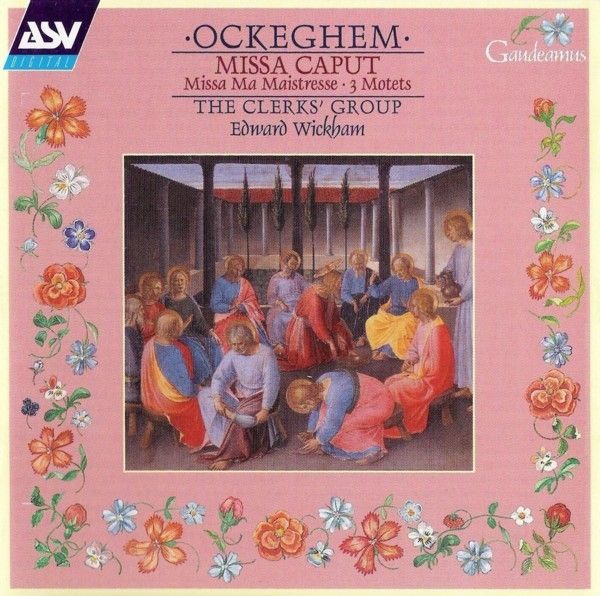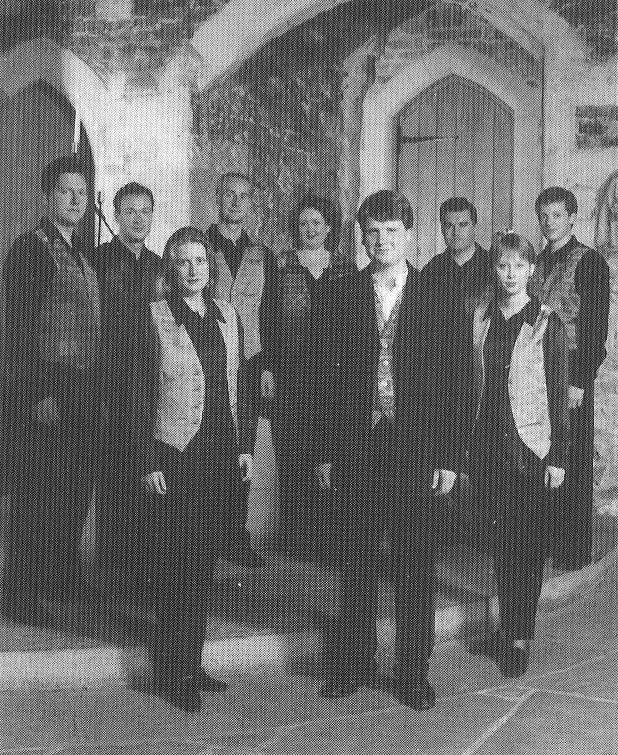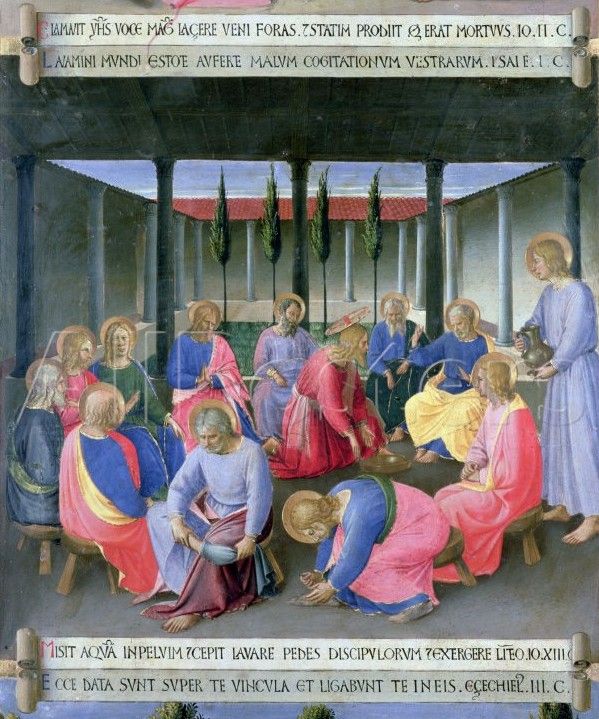Johannes OCKEGHEM. Missa Caput / The Clerks' Group
Johannes OCKEGHEM. Ma maistresse · Missa Ma maistresse
anonymi from Trent 88 · Venit ad Petrum (sarum chant)

medieval.org
AS&V "Gaudeamus" CD GAU 186
1998
Missa Ma maistresse
1. Kyrie [2:42]
2. Gloria [6:08]
3. Ma maistresse [6:30]
an., Trent 88
4. A solis ortus cardine [7:30]
5. O sidus Hispanie [2:45]
6. Gaude Maria [6:14]
Sarum chant
7. Venit ad Petrum [2:01]
Missa Caput
8. Kyrie [3:12]
9. Gloria [7:36]
10. Credo [8:15]
11. Sanctus / Benedictus [8:03]
12. Agnus Dei [6:22]
THE CLERKS' GROUP
Edward Wickham
sopranos: Carys Lane, Rebecca Outram
altos: Robin Blaze, Patrick Craig, William Missin
tenors: James Gilchrist, Matthew Vine
basses: Edward Wickham, Jonathan Arnold, Robert Macdonald
Produced by Jonathan Freeman-Attwood
Recorded by Paul Proudman / ProudSound
Recorded in St. Andrew's Church, West Wratting, 6-7 November 1997
Designed by Studio B, The Creative People
Cover: The Washing of the Feet, originally drawers from a chest
storing silver (tempera on panel)
by Fra Angelico (Guido di Pietro, c.1387-1455); Museo di San Marco
dell'Angelico, Florence /
Bridgeman Art Library, London/New York

That two such markedly different masses as Missa Ma maistresse
and Missa Caput could be composed by the same man is as much a
comment on the ever-eccentric, ever-innovatory nature of Ockeghem's
polyphony as it is on the rapidly changing musical landscape of the
fifteenth century. Indeed, if there is one characteristic which seems
to link Ockeghem's masses, it is eccentricity. A series of the complete
works of any composer inevitably forces some pieces of music into
awkward intimacies, but there is little comparable to either of these
masses in any of Ockeghem's surviving oeuvre. To make all things new
might have been Ockeghem's motto.
Missa Ma maistresse probably dates from late in Ockeghem's
compositional career (a career which, if the surviving works are any
indication, ended perhaps as much as 15 years before he died). Based on
material from Ockeghem's own song, this mass goes far beyond the
traditional practice of integrating only the tenor from the model: here
the mass is suffused with quotations, reworkings and parodies of the
song material, because of which it has been named among the first
"imitation" or "parody" masses. Only two movements survive from what
was surely a full-length mass, but they reveal a lighter, sunnier
aspect to Ockeghem's style, a style which has so often been regarded as
demanding and cerebral. In particular, the rhythmic density of the
writing, and the amount of almost incidental detail in the lower voices
create textures of infectious vitality. In this, as in its protoparodic
nature, the mass might closely resemble the five-part Missa Fors
seulement, another apparently late work, but that here the higher
vocal ranges require a different configuration of ensemble.
Ockeghem's concern with varying choral textures, and exploiting the
aesthetic potential of vocal scoring is apparent throughout his work.
Rarely more so, however, than in Missa Caput, a setting as
peculiar, enthralling and controversial as any in the Renaissance. The
opening bars of the Kyrie fall upon the ear like a series of
detonations, none of them expected, each of them with its own power to
shock. The reason for this lies in the puzzle Ockeghem has set his
singers. A superficial glance at the manuscript sources for the mass
would reveal what looks like a traditional vocal layout: the tenor
part, carrying the cantus firmus line, lies beneath the superius on the
left hand side, and opposite lies the contratenors altus and bassus
(sometimes also described as tenor secundus). The arrangement of clefs
appears the same as a number of contemporary four voice masses. But
this happy family of voices is rendered dysfunctional by a canon which
demands that the tenor cantus firmus be sung an octave lower. Now out
of range of the average tenor, the basses take on the responsibility of
the cantus firmus, and the tenor moves over to sing the tenor secundus.
The cantus firmus of Missa Caput is derived from the long
melisma on the word "caput" which appears at the end of the antiphon Venit
ad Petrum. For centuries a mystery, the provenance of this melody
was finally tracked down by the scholar Manfred Bukofzer to England,
and the Sarum chant tradition. The chant became known to continental
composers through an anonymous mass which employed the same melisma,
the mass itself was hugely influential on a circle of Northern European
composers, a circle which Ockeghem, during his time at Antwerp, might
well have been a part of. As a traditional tenor cantus firmus the
Caput melisma is awkward, but as the bass part it is downright obtuse.
Part of the pleasure of repeated experience of the mass, whether
through listening or singing, is the appreciation of how Ockeghem
negotiates the challenges which he has set himself. In the days before
modern editions, and editorial intervention in musica ficta, the
pleasure of working out puzzles must have also provided an attraction
to singers. There are no exclusively correct answers to many of the
ficta puzzles presented by Missa Caput, and one imagines that
each performance in the fifteenth century was different. This recording
presents only one possible set of answers.
To discuss Missa Caput merely as a musical mind-twister,
however, would be severely to misrepresent it. It is a work whose style
has been described as quintessentially Ockeghemian: the long,
apparently illogical lines, the often dense, dark textures. To hear it
is to hear Ockeghem at his most challenging and bizarre. In particular,
much has been made of Ockeghem's avoidance of cadence, a feature which
— it is said — gives the music a timeless, seamless
quality, other-worldly, irrational, mystical. It is natural for us to
want to fit Ockeghem's music — as we do so many other artists'
works — into an image which is attractive to us now. Here we have
a declension of adjectives leading us from a distinct stylistic trait
— the avoidance of cadence — to an indistinct psychological
tag — "mystical": a declension which has been recited all too
often. Ockeghem's mass writing is full of rhetorical power, and is
constantly charged with a dynamic which pushes the musical argument
forward. In the case of Missa Caput this argument is structured by the
cantus firmus, which remains unaltered throughout. And far from
avoiding cadences, the mass seems to be cadencing all the time,
anywhere and everywhere. If there is a sense of timeless stillness, it
is only like the spinning top which spins so fast that it appears
motionless. Or to take an analogy contemporary to Ockeghem, it is like
Nicholas of Cusa's sphere which rotates at infinite velocity, so that
each point on the surface is everywhere at the same time.
The three anonymous works on this recording can be found in the
manuscript Trent 88, also the earliest source of Missa Caput.
A solis ortus cardine is a hymn setting in which the melody is
carried, in an elaborated form, in the upper voice. As was common in
the first half of the century, Trent 88 provides two
arrangements of the polyphony, one for three and one for four voices,
the latter presumably a later re-working in order to satisfy a
developing taste for four part music and the exploitation of the bass
voice. On this recording we have given both versions. O sidus Hispanie
is a motet in honour of St Anthony of Padua: another treatment of this
text, attributed to Dufay is transmitted next to this one in Trent
88, and despite their very different characters, this joyful 5-part
setting may also be by Dufay, who had a particular veneration for St
Anthony. Gaude Maria is the most modern of these three works,
in format and structure resembling the mass composition of the Caput
era. The tenor carries the plainchant Meditatio cordis, linking
it to a mass in the later Strahov Codex which uses the same
tenor material. Indeed, it has been suggested that this motet is the
missing Kyrie from that mass, with a contrafactum text
inserted. If this is so, then it is very likely that the composer of Gaude
Maria and the Strahov mass was English, since continental scribes
often excised or altered the Kyries of English masses because of their
trope texts, which did not conform to continental liturgical practise.
© Edward Wickham, 1998



